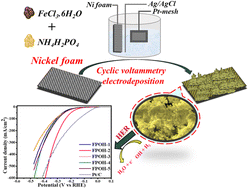Transition metal phosphates (TMPs) have evolved as one of the highly promising electrocatalysts for dissociating water due to their remarkable catalytic qualities. Herein we have successfully synthesized iron phosphate hydroxide hydrate on a nickel foam substrate by an electrodeposition method and the molar ratio was optimized to achieve the lowest possible overpotential required to form hydrogen gas. The proton acceptor (negatively charged phosphate (P) sites) and hydride acceptor (coordinated metal sites) promote proton adsorption at the electrocatalyst surface during water electrolysis and enhance the performance. Despite this advantage, phosphate materials are not stable over a period. Therefore, to prevent the degradation and material dissolution, a particular composition of Fe3+ and Fe2+ is obtained to suppress the oxidation of the material. The catalyst Fe3(PO4)(OH)6·3H2O exhibits the highest mass activity with a tuned Fe3+/Fe2+ ratio and resulted in a lower overpotential of 130 mV at 10 mA cm−2 for the hydrogen evolution process. Furthermore, this catalyst is electrocatalytically stable for 80 h at 100 mA cm−2 current density with low activity degradation.

